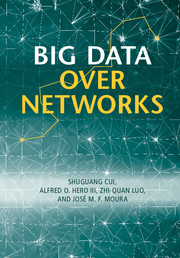Book contents
- Frontmatter
- Contents
- List of contributors
- Preface
- Part I Mathematical foundations
- Part II Big data over cyber networks
- 5 Big data analytics systems
- 6 Distributed big data storage in optical wireless networks
- 7 Big data aware wireless communication: challenges and opportunities
- 8 Big data processing for smart grid security
- Part III Big data over social networks
- Part IV Big data over biological networks
- Index
- References
7 - Big data aware wireless communication: challenges and opportunities
from Part II - Big data over cyber networks
Published online by Cambridge University Press: 18 December 2015
- Frontmatter
- Contents
- List of contributors
- Preface
- Part I Mathematical foundations
- Part II Big data over cyber networks
- 5 Big data analytics systems
- 6 Distributed big data storage in optical wireless networks
- 7 Big data aware wireless communication: challenges and opportunities
- 8 Big data processing for smart grid security
- Part III Big data over social networks
- Part IV Big data over biological networks
- Index
- References
Summary
The fast-growing wireless data service is pushing our communication network's processing power to its limit. The ever-increasing data traffic poses imminent challenges to all aspects of the wireless system design, such as spectrum efficiency, computing capabilities, and backhaul link capacity, etc. At the same time, the massive amount of mobile data traffic may also lead to potential system performance gain that is otherwise not achievable with conventional wireless signal processing models. In this chapter, we investigate the challenges and opportunities in the design of scalable wireless systems to embrace such a “big data” era.We review state-of-the-art techniques in wireless big data processing and study the potential implementations of key technologies in the future wireless systems. We show that proper wireless system designs could harness, and in fact take advantages of the mobile big data traffic.
Introduction
After decades of rapid growth in data services, modern society has entered the so-called “big data” era, where the mobile network is a major contributor. As of the year 2013, the global penetration of mobile subscribers had reached 92%, producing staggeringly 6800 PetaBytes (6.8 × 1018) of mobile data worldwide [1]. The surge of mobile data traffic in recent years is mainly attributed to the popularity of smartphones, mobile tablets, and other smart mobile devices. Mobile broadband applications such as web surfing, social networking, and online videos are now ubiquitously accessible by these mobile devices, without limitations from time and location. The recent survey shows that the number of smartphone users currently accounts for merely 25%–30% of the entire mobile subscribers. However, the figure will double in the next three years and continue to grow given the considerable room in the smartphone market for further uptake.With a compound annual growth rate of 45%, it is expected that the mobile data traffic will increase by ten times from 2013 to 2019.
In addition to the vast amount of wireless data, wireless signal processing often amplifies the system big data effect in the pursuit of higher performance gain. To combat the fading channel, diversity schemes, especially the MIMO antenna technologies, are extensively used in both mobile terminals (MTs) and base stations (BSs). Numerous schemes with co-located and distributed antennas have been proposed over the years to increase the data rate or extend the cellular coverage.
- Type
- Chapter
- Information
- Big Data over Networks , pp. 180 - 216Publisher: Cambridge University PressPrint publication year: 2016
References
- 3
- Cited by

